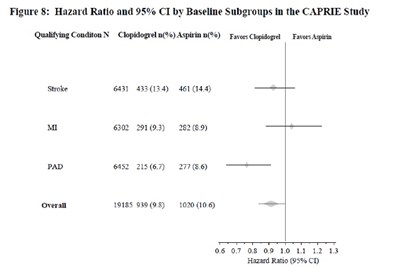Product Images Clopidogrel Bisulfate
View Photos of Packaging, Labels & Appearance
Product Label Images
The following 10 images provide visual information about the product associated with Clopidogrel Bisulfate NDC 71335-1646 by Bryant Ranch Prepack, such as packaging, labeling, and the appearance of the drug itself. This resource could be helpful for medical professionals, pharmacists, and patients seeking to verify medication information and ensure they have the correct product.
figure1 - clopidogrel fig

This is a figure showing the effect of proton pump inhibitors (PPIs) on exposure to Clopidogrel active metabolite after multiple doses of Clopidogrel 75 mg. The figure includes mean and 90% confidence interval values for PPIs like Deslansoprazole, Lansoprszole, Pantoprazole, and Omeprazole, and how they affect active metabolite AUC. It also shows the change relative to Clopidogrel administered alone.*
figure3 - clopidogrel fig2

This is a medical study comparing the effectiveness of a placebo (with aspirin) group versus a group taking clopidogrel (with aspirin) in preventing cardiovascular death, myocardial infarction, and stroke. The study shows a significantly lower cumulative event rate in the clopidogrel group. The study followed patients for up to 12 months and standard therapies were also used.*
figure4 - clopidogrel fig4

The image shows the cumulative event rates for death in the COMMIT study, with a comparison between the placebo group and the clopidogrel group. Before the first discharge, 8.1% of patients on the placebo died, while 7.5% of patients on clopidogrel died. There was a 7% proportional risk reduction (with a p-value of 0.03) for patients on clopidogrel. The x-axis shows the days since randomization (up to 28 days) and all treated patients received aspirin.*
figure5 - clopidogrel fig5

This text compares the effectiveness of two medications, placebo and clopidogrel, in reducing the risk of death, re-infarction, or stroke. Based on the data, clopidogrel has a 9% lower proportional risk compared to placebo. Additionally, there was a 7% reduction in death with clopidogrel compared to placebo (p=0.002). The text includes a graph showing the number of events over time since randomization, up to 28 days.*
figure6 - clopidogrel fig6

This appears to be a table or figure from a study called COMMIT investigating the effects of adding Clopidogrel to Aspirin on a primary endpoint. The table/figure shows the effects across different subgroups based on baseline and concomitant medication. Unfortunately, there's not enough information to decipher the units, values, and outcomes presented in the figure due to the unclear .*
figure7 - clopidogrel fig7

This document appears to be a graph or chart showing the cumulative event rate for fatal or non-fatal vascular events over 24 months of follow-up for two medications: aspirin and clopidogrel. The x-axis represents the time in months, while the y-axis represents the percentage of patients experiencing a vascular event. The chart displays data points at 6-month intervals. Without additional information, it is not possible to provide further context or interpretation.*
figure8 - clopidogrel fig8

This is a table showing the hazard ratio and confidence interval by baseline subgroups in the CAPRIE Study for a qualifying condition. There are three subgroups: stroke, M (not clear what this stands for), and PAD. The table displays the number of participants for each subgroup and the percentage of those who took Clopidogrel or Aspirin, as well as the hazard ratio and 95% confidence interval.*
Label Image - lbl713351646

This appears to be a description of a medication called Clopidogrel, which comes in 75mg tablets. It is manufactured by ScieGen Pharmaceuticals and is a generic equivalent to Plavix. The tablets should be stored at room temperature between 20°C to 25°C (68°F to 77°F) and kept tightly closed. The text also includes a lot number, an expiration date, and the National Drug Code (NDC) for the tablets. There is also some text that may be referencing a ranch and a bank, but it is not clear how it relates to the medication.*
* The product label images have been analyzed using a combination of traditional computing and machine learning techniques. It should be noted that the descriptions provided may not be entirely accurate as they are experimental in nature. Use the information in this page at your own discretion and risk.

